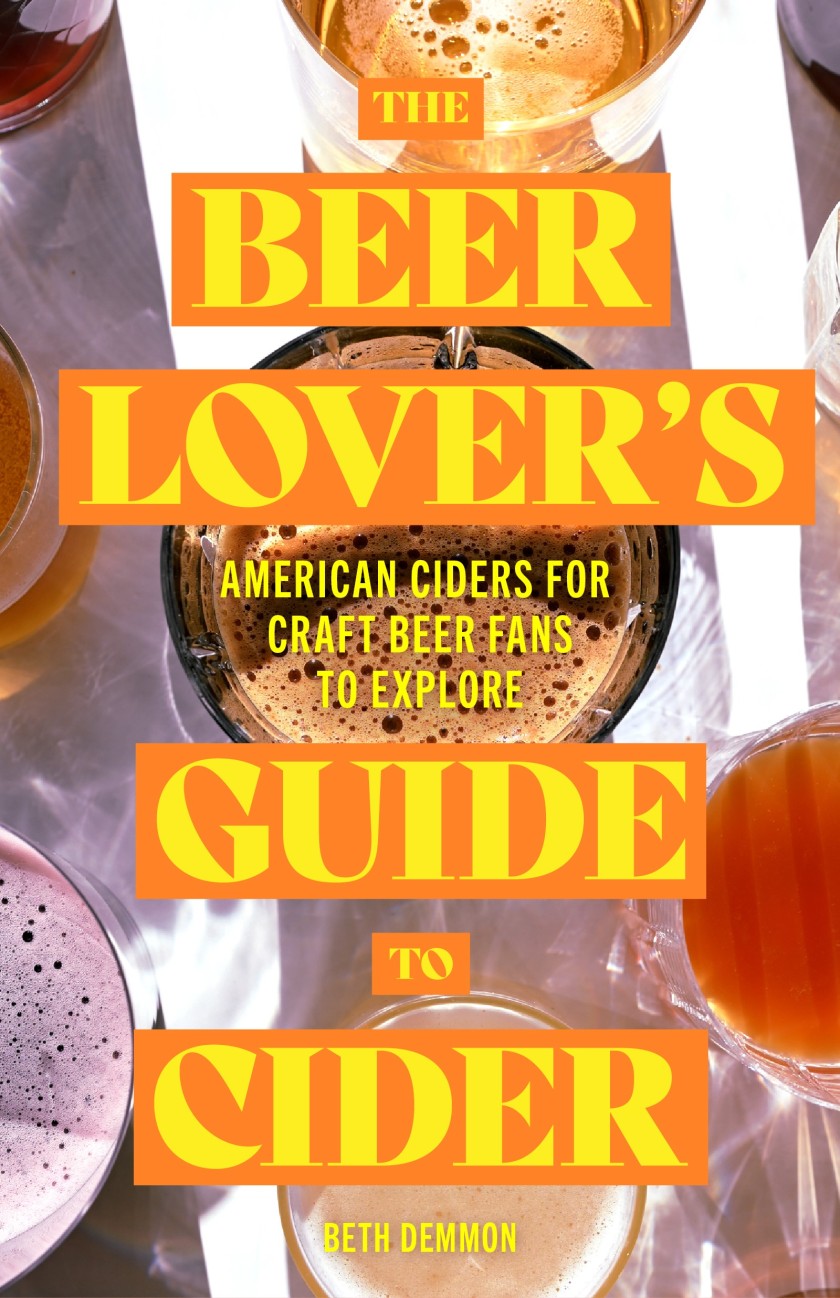Y’all are here reading Cider Review because, logic would inform me, you either already love cider and perry or you’re at least a little bit cider-and-perry-curious. Whether you fall into the first or the latter group, Beth Demmon’s Beer Lover’s Guide to Cider has something for you. Even if you don’t fall into either and are here by mistake (in a Withnail On Holiday sense), you will, I assure you, find content of substance and pleasure within these pages.
I will admit, hands down, to being biased on dual fronts. A short Google search will inform you that a) Beth is my friend, and b) I am a beer drinker who loves cider. However, neither of these caveats changes the fact that this book is an excellent introduction to contemporary American cider for pretty much everyone. It is also a joyful sensory exploration of cider’s wonderful plethora of flavour qualities as well as an outstanding guide to cider and food pairing, richly detailed with lovingly crafted descriptions of flavour combinations way above the paygrade of the most foodiest of foodies.

When I opened Beth’s book on a grim, grey day when the sun that inspires cider-drinking was nowhere to be seen and I was feeling decidedly under the weather, I unexpectedly found myself craving a cool tall glass of cider. Beth’s prose is filled with a passion for the ciders she describes that contagiously pops off the page and onto your tastebuds. But I’m getting ahead of myself here.
The book’s purpose is to encourage beer drinkers to give cider a try, and is structured as a style and flavour-based guide to introduce beer drinkers to the world of cider via their preferred beer styles by matching them to a range of ciders from across the US. The book begins with a lovely forward from beer and cider writer-extraordinaire Jeff Alworth, followed by a precise of Beth’s own journey into cider and some key cider takeaways. Each chapter then focuses on a flavour-based style, such as light/introductory, hoppy or fruity, and offers ten cider equivalents to beers that fit into that category. While this might sound simple, trust me, it is anything but. Although the US cider scene is still small (approximately 1,700 producers compared to approximately 9,000 craft breweries), the precision and care that Beth has put into picking exactly the correct ten ciders to convert, for example, a committed IPA-loving hophead to her cause, is evident in the effusive yet specific descriptions she provides for a total of 80 ciders. This is a labor of love.
As a beer writer as well as a cider writer, Beth grasps the vagaries and nuances that beer drinkers can be partial to. Be it our Pokemon-esque rarity-obsessiveness, bang-for-ya-buck ABV-awareness or annoying chin-stroking over-analysing of flavour, Beth has it all covered. Her introduction outlines cleanly and simply the difference between beer and cider, in terms of production, character and tasting, while drawing on enough similarities to make a beer drinker feel at home. Even if you are familiar with cider, Beth’s distillation of apple varietals and how to taste them is a useful tool, and her overall points about how to taste and develop an understanding of flavor apply accurately to any beverage.

The flavour-based chapters feature everyone from big names like Shacksbury and Reverend Nat’s to artisan-extraordinaries like Eden and Artifact. I was impressed and, as a fellow cider writer, slightly embarrassed by how many ciders and cideries Beth features that I had never come across which sound absolutely phenomenal. For example, Left Bank Ciders from Catskill NY who make small-batch ciders from unsold apples from their local farmer’s market, and Courtland, CA’s Hemly Cider, whose fascinating range of beverages includes a perry made with regenerative seaweed (Daybreak). Her research is impeccable and while I am slightly envious at the thought of trying as many ciders as she doubtless did to write this book, I am in awe of the work it would have taken to analyse and pare these down to just 80 style-focused winners, particularly in a manner that is relatable and unintimidating to beer drinkers.
As much as the pairings themselves are on-point and accurate, Beth’s writing is a joy unto itself. As I read, I began slinging post-its whenever I found a particularly piquant quote to share with y’all, but this swiftly got out of hand as there were just too many. “If adults ever got a snow day, [Cidergeist’s] Snug would be the cider to drink while watching through the window as snowflakes fall” is just one of her lovely evocative descriptions that make you want to live out that moment the way it’s written on the page. Another comes when describing Son of Man’s awesome-sounding Basajaun collaboration Basque-style cider. “American beverage makers have long danced between paying homage to traditional European styles and channeling that inspiration to a new world audience,” she writes. “Basajaun acts as such a bridge between both, leaving lucky tongues salivating in ecstasy. Funk occupies the centrepiece of this cider alter so give into a transcendent experience…” Yes please.
When it comes to tasting notes, Beth drills down with precision so you’ll know exactly what to expect. Raging Cider & Mead Company’s Hyslop Single Varietal (2019) is described as “A highly acidic, structured and somewhat chewy cider packed with barrel aroma and flavour that leans towards leather and tannins… thanks to its rich apple backbone, this challenging but compelling cider provides as standout look at a classic cider crabapple.” Seriously, tell me you don’t want to drink this right now?

Beth’s food pairings clearly come from a place of practice and passion. Going beyond cider staples like cheese and charcuterie (which do feature of course), she invokes the likes of ube pandesal (noted as sweet, pillowy and bright Filipino bread rolls) to pair with Snow Capped Cider’s Gold Rush and takoyaki (Japanese octopus balls) with Durham Cider & Wine Co.’s These are the K.B.’s (2020). It’s not all high-falutin foreign fare though. Beth emphasizes the pleasure in enjoying local dishes with cider made nearby, as well as running the gamut of foodstuffs to suit all palates, from fresh oysters to grilled nectarines, pot roast to dill pickle pizza (yes, you read that right), there really is a cider in here for whatever you want to eat, whether you’re swapping it out for a beer or not.
In summary, Beth Demmon’s Beer Lover’s Guide to Cider is a considered and inviting introduction to the huge scope and variety of flavour that cider has to offer beer drinkers. It is also a clever and thoughtful catalogue of food pairings for every style of cider, and a great way to get to know a wide range of American craft ciders and cideries, whether you’re a beer drinker or not. Beth’s emphasis on flavour and its growing importance among ‘ombibulous’ drinkers is timely and accurate, and if you want to get to know contemporary American cider, whomever you are, this is a perfect place to start.

All photos in this article taken by Jess Hicks, other than the lead image of the book cover, which was taken by Luke Schmuecker
Discover more from Cider Review
Subscribe to get the latest posts sent to your email.

Pingback: Cider Review article: ‘The Beer Lover’s Guide to Cider by Beth Demmon’ – Craft Beer Amethyst
Pingback: Cider Review’s review of the year: 2023 | Cider Review